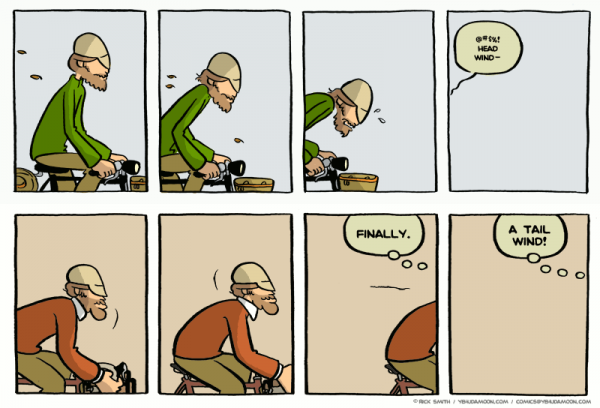Cycling in Strong Winds
 It’s race day and you’re confident in your skills, your bike, and your training. You’ve been practicing drafting, breakaways, and tactics so that you have enough energy for that final push at the end. The one thing you may not have counted on is the strong winds that forecasted for that day. Cycling in strong winds can play tricks on you. Here’s a few tips on how best to handle it.
It’s race day and you’re confident in your skills, your bike, and your training. You’ve been practicing drafting, breakaways, and tactics so that you have enough energy for that final push at the end. The one thing you may not have counted on is the strong winds that forecasted for that day. Cycling in strong winds can play tricks on you. Here’s a few tips on how best to handle it.
Wind Resistance
Wind resistance always shapes tactics because a rider can use wind resistance to his or her advantage. At speeds over 30 kph, aerodynamics becomes very important even without a strong wind. Using a good position on the bike will limit the amount of body surface that is available for the wind to hit and cause resistance.
A good position to have is with your elbows drawn toward your body, your head down, and leaning forward. With luck the person in front of you will not be in this position blocking more wind and making it easier to jump into their slipstream, dramatically reducing your wind resistance and effort by as much as 30%.
Crosswinds
This is when the wind is coming directly from the side and it can actually be dangerous. If a large gust of wind suddenly and forcefully hits your front tire, your wheel can catch in that wind, turning it to the side causing you to lose control of your bike. If you know that the day is going to be windy, you may want to change up your bike set up a little bit. Shallow rims are lightweight and are not as easily affected by crosswinds. In general you want to avoid rims that are deeper than 50 mm on the front. The back wheel can handle a deeper dish because more of your body weight is on it.
Also be aware that the crosswinds provide the most aggressive racing conditions and you will need to plan accordingly. While most drafting occurs in single file, crosswinds require drafting in a diagonal pattern, called echelon. Because there is minimal width on roads, someone will eventually have to pull ahead and ride in the wind. Suddenly people have to choose between wind and win. This causes some very aggressive tactics in order to hold a line.
Additionally, it is more likely that someone in the peloton gets tossed to the side by an unexpected crosswind so it is even more important that your front wheel is behind and clear of their back wheel. If you have any crossover and the rider in front of you swerves and hits your front tire, you are the one that is going to go down!
Tailwinds
When cycling in strong winds many people think that a tailwind can only be advantageous as it will push them and give them additional speed. Although this is true, most rides are circular which means that if you start with a tailwind you’ll end with a headwind. Many riders forget about this and waste their energy pedaling as fast as they can in the tailwind to boost their time or position. This leaves them with little to no energy left to battle that headwind and inevitably leaves them in a much worse position. (We have all been there) Always plan your strategy carefully when there’s going to be strong winds during a ride/race.
If you are in a group and it is your turn to pull, (take the lead) then it is actually beneficial to do so when there is a tailwind as the effort will decrease at the front to maintain the speed (same with uphills). So to save energy while riding try to take the lead on tailwinds and uphills and drop back and get protected on crosswinds and headwinds.
Headwinds
I am not aware of anyone who loves a good headwind! It is deceptively difficult to gauge effort and most of us see how slow we are going and over exert ourselves. Cycling in strong winds 101: try to effectively gauge effort without using speed. Headwinds can be deceiving, energy sapping, mind sucks. Don’t get sucked in to the trap of redlining every time you slow down, better yet, get a power meter to tell you exactly how much power you are churning out.
Clothing
Strong winds provide a greater opportunity for wind resistance that you can effectively battle with the proper clothing. Wear your tightest shorts and jersey that can still let you move comfortably. With tighter clothing the wind will slip around your body and you’ll have minimal fabric flapping about. This provides great aerodynamics and can help you much more than you think. You’ll also want to have a good aerodynamic helmet so that wind will slip over your head and down your body.
Cycling in strong winds requires careful tactics and planning because it can result in difficult or aggressive racing. You need to pay close attention and use all of your skills and training in order to maintain a good pace throughout.